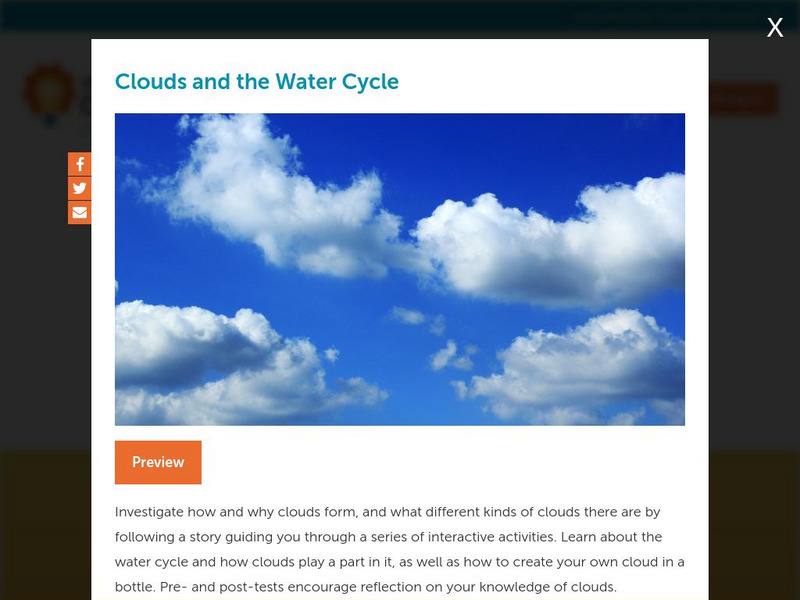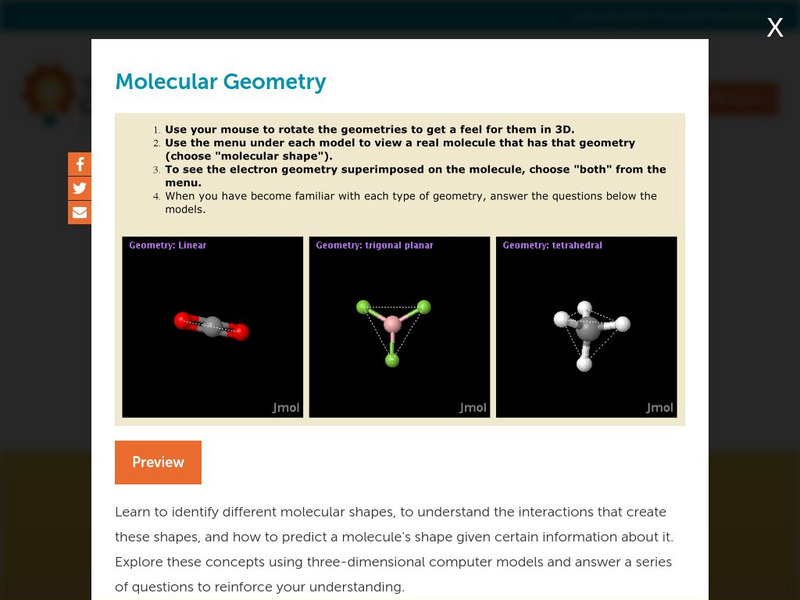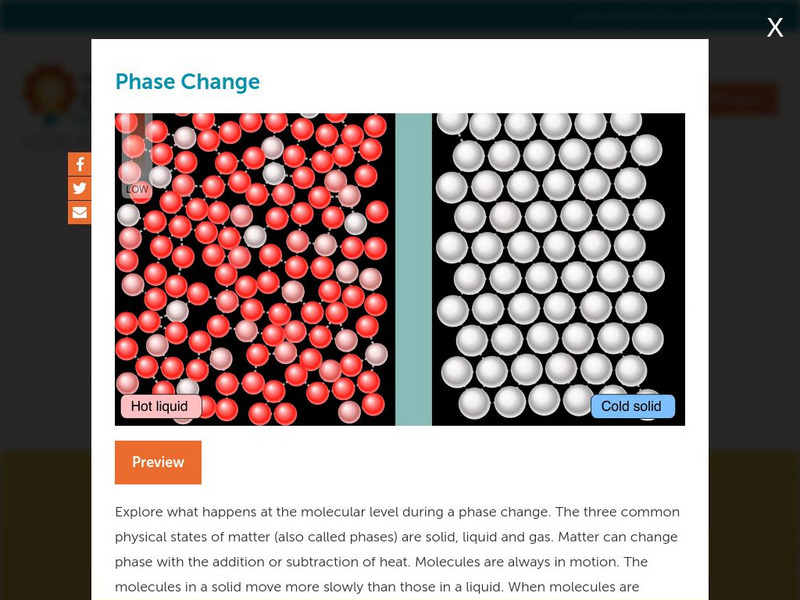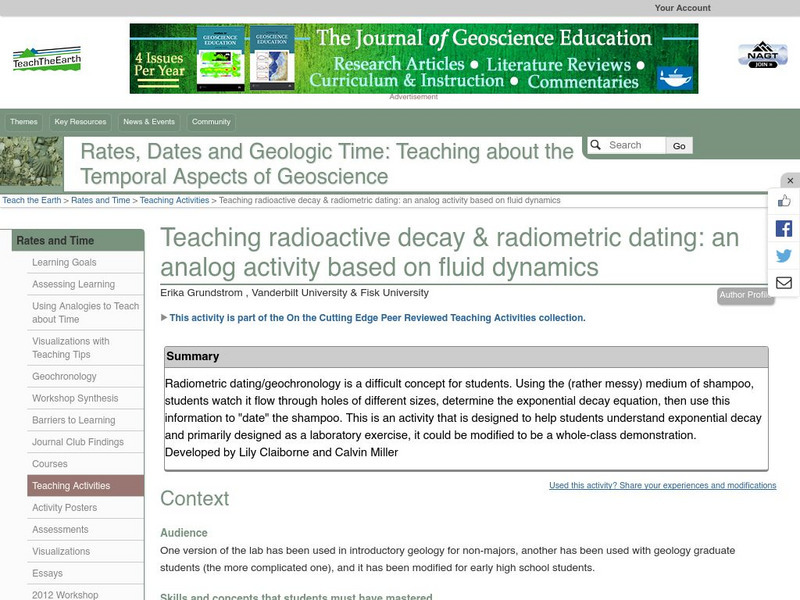Concord Consortium
Concord Consortium: Stem Resources: Atoms and Energy
Online activity walks learner through exploration of kinetic and potential energy using animations. Through graphs, a quantitative connection is made between the movement and the energy involved. This information is then related to the...
Concord Consortium
Concord Consortium: Stem Resources: Beginning Clouds Unit
Explore how clouds are formed with the computer-based model in these interactive activities. Also learn about clouds part in the water cycle. Activity includes pre- and post-tests which can be saved and graded by the teacher.
Concord Consortium
Concord Consortium: Stem Resources: Electrostatics
This web-based activity takes students through a series of pages in which they find out about the effects charged particles have on one another, discover how Coulomb's force works, and see some real-world examples. Multiple-choice and...
Concord Consortium
Concord Consortium: Stem Resources: Chemical Reactions
This web-based activity gives students an opportunity to write chemical reactions, balance chemical equations, and explain what is happening during a given chemical reaction. Also addressed is the effects of concentration and temperature...
Concord Consortium
Concord Consortium: Stem Resources: Cellular Respiration
Web-based activity provides an opportunity for students to study cellular respiration in an up-close and personal way. By following atoms and molecules through an interactive animation, they will be able to see the changes that take...
Concord Consortium
Concord Consortium: Stem Resources: Chemical Bonds
By working through this web-based activity, students differentiate between ionic, non-polar covalent, and polar covalent bonds. Specifically, distinctions are made between bonding types based on orbital shapes and electronegativity...
Concord Consortium
Concord Consortium: Stem Resources: Molecular Geometry
Students work through animated models showing the effects that electron repulsions have on the shape of a molecule in this web-based activity. In addition, shared and unshared electron pairs are demonstrated to define a molecule's shape....
Concord Consortium
Concord Consortium: Stem Resources: Phase Changes
This activity reviews of states of matter, then relates them to atomic movement as it is affected by attractions between atoms and the addition of energy. Latent heat and evaporative cooling are also topics covered. Multiple-choice and...
Concord Consortium
Concord Consortium: Stem Resources: Solubility
Learners can use this web-based activity to study solutions, as far as the intermolecular attractive forces that allow or do not allow a solvent to dissolve in a solute. Also discussed includes the solubility rule "like dissolves like"...
Concord Consortium
Concord Consortium: Stem Resources: Spectroscopy
Web-based activity walks learners through the use of spectroscopy in determining the identity of atoms and molecules by defining the excited state of atoms, the frequencies of emitted photons, and atoms' ability to absorb them....
Science Education Resource Center at Carleton College
Serc: Teaching Radioactive Decay & Radiometric Dating
A laboratory activity that teaches the difficult concept of radioactive decay by means of a fluid (shampoo) flowing through holes from an upper to a lower beaker. Using the exponential decay equation, students then 'date' the shampoo....
Concord Consortium
Concord Consortium: Stem Resources: Photosynthesis
This activity introduces the concept of plant color being determined by pigments, which interactive with light. The idea that chlorophyll is used by plants for energy is then discussed, along with the first step of the photosynthetic...
TESL Journal
Bilingual English Portuguese Vocabulary Quizzes
This site offers vocabulary-building quizzes that can be used either by learners of English or by learners of Portuguese to test knowledge of the English and Portuguese words for colors, days, months, seasons, greetings, fruits,...
Other
Growing With Grammar: Consonant Digraphs Wr, Kn, and Ck; Schwa Sound [Pdf]
This file contains two five-day spelling/vocabulary lessons. The first lesson covers words which contain the wr, kn, and ck digraphs; the second lesson covers words which contain the schwa sound. Each lesson contains a list of words with...
A to Z Teacher Stuff
A to Z Teacher Stuff: Bats Sample Lesson Plan (Grade 4)
This site provides a lesson plan on bats that contains links to a pre-test, notes on bats, and a post test.
AdLit
Ad lit.org: An Introduction to College Access Programs
Most college access programs provide activities such as financial counseling, last dollar scholarships, college visits, career guidance, tutoring, academic counseling, and test preparation courses. These comprehensive college access...













![Growing With Grammar: Consonant Digraphs Wr, Kn, and Ck; Schwa Sound [Pdf] Unit Plan Growing With Grammar: Consonant Digraphs Wr, Kn, and Ck; Schwa Sound [Pdf] Unit Plan](https://static.lp.lexp.cloud/images/attachment_defaults/resource/large/FPO-knovation.png)

